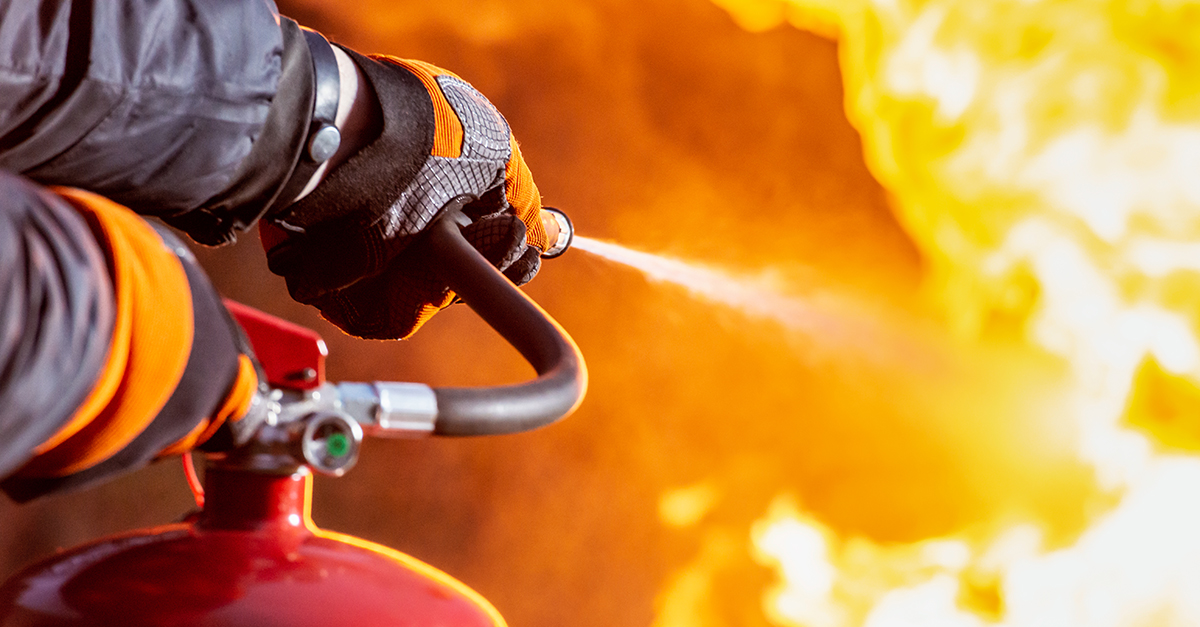That toaster in the typical office building’s break room seems innocuous. But Kevin Feak, a senior fire protection engineer at architecture and engineering firm LaBella Associates, knows toasters are not so harmless.
Feak, who regularly conducts facility inspections to check on life safety systems, recalled an instance when an office facility stored a toaster on the kitchen countertop, directly below a paper towel
dispenser. He said normally office residents would pull the toaster out from under the paper towels, put in their bagel, and everything was fine. But then someone neglected to pull the toaster out, and the heat from the toaster ignited the paper towels, which in turn spread flames to the cabinet above.
“It was just a momentary lapse of judgment,” Feak said. “Somebody came into the kitchen to toast something, walked out, and while the toaster was left unattended, the cabinet caught on fire.”
Pay attention in the kitchen
Looking back on past inspections, Feak lists kitchens as one of the top facility areas at risk of fires. “Anything with an open flame is going to pose a risk,” he said. “Ovens are definitely a hazard, but within office buildings, the biggest issues are toasters and hot plates.”
Feak believes many kitchen fires would be prevented if people monitored what they are cooking. “So many different people are coming in and out of office kitchens,” he explained. “Cooking is a secondary activity to what they’re doing, and everyone has something else on their mind. So, they might not realize they forgot to tear the plastic off the food they put in the toaster oven.”
To prevent fires from simple cooking tasks, facility managers can post signage asking people to stay in the kitchen while they heat food. They can also hold periodic safety meetings in which
they ensure all staff members know the location of fire extinguishers and are comfortable using them so they can control small kitchen fires before they spread to the rest of the building, Feak advised.
Facilities must have fire extinguishers distributed throughout the entire building, placed 75 feet apart from each other for easy walking distance, and 40 feet from every exit, according to
Steve Lockwood, managing member of Mountain State Fire Protection, a company that inspects and repairs fire protection systems.
Commercial kitchens with larger cooking equipment, such as stoves and deep fryers, require additional precautions. Lockwood cautioned against rearranging stoves and other cooking tools, as all equipment must be at a specific distance from its fire suppression system for it to be effective.
“Usually [the cooking equipment] is on wheels and people like to move it around the kitchen,” he explained. “But each has its own nozzle [to the suppression system], and if you move it around,
you run the risk of it being too far from the system and not complying with the fire code.”
Commercial kitchens also contain exhaust hoods that can collect grease buildup if they are not cleaned frequently. Lockwood recommended that facility managers in commercial kitchens schedule exhaust hood cleanings regularly.
“Twice a year is good,” he said. “And keep up with your system inspections and maintenance.”
Periodic inspections of the fire alarm and sprinkler systems are also crucial, “so you are containing the event to one room and not putting out a fire in the entire building,” Feak added.
Rein in electricity
Outside of the kitchen, electrical rooms, the location of electrical circuits and panels powering the entire building, are another common area for facility fires, Lockwood said. He pointed to obvious problems such as overloaded circuits, faulty wiring, and outdated panels. “Facilities should have an electrician come in regularly and do a visual inspection and make sure electrical components look as they should, with no loose or broken wires,” Lockwood said.
A less obvious hazard in electrical rooms is clutter. “A lot of times these electrical rooms double up as storage rooms, and that’s not always the best practice,” Lockwood said, explaining that clutter provides fuel to spread any fires that ignite.
Lockwood stressed that electrical rooms must contain carbon dioxide fire extinguishers, which are specific to putting out electrical fires. “These fire extinguishers are a lot less messy, and they don’t damage equipment,” he said. “They are also useful in facility areas with expensive electronic equipment.”
Outside of the electrical room, electrical malfunctions throughout the facility, often caused by user error or system overload, can spark fires.
“People often overpower the circuits, especially around the holidays when they are having office parties and bringing in hot plates and crock pots,” Feak said. “They plug these appliances into
the kitchen, then turn on the microwave, and it overwhelms the system.”
Feak recommends that facility managers ensure all electric circuits are sized appropriately for facility needs and limit the number of outside appliances office residents can bring. “Have your electrical team inspect all outside appliances to make sure they are UL-listed with no frayed cords and have the ability to be grounded,” he advised.
With winter approaching, facility managers need to monitor any space heaters people bring into the facility. “Space heaters are such a nightmare to deal with; they are big energy hogs and a drain on the electric system,” Feak said.
Plugging space heaters into the system can cause circuit breakers to pop, requiring the maintenance team to reset circuits constantly. They also increase the risk of electrical fire.
“Electrical fires are so dangerous because they are out of sight, behind the walls,” Feak explained. “By the time the fire is found, it has grown to a point where the facility has to do major renovations.”
Feak suggested that facility managers conduct an electrical inspection of all space heaters, ensuring they pull 600 watts or less, have a feature that automatically shuts them off if they tip over, and
they don’t have exposed heating coils. “Some of the older models heat up with metal coils, similar to how a toaster heats up,” he explained. “Newer ones have heating elements that are infrared or ceramic, which pose less chance of a fire if something comes in contact with the heating element.”
The most common electricity user error is the improper use of extension cords and power strips. “I can almost guarantee that any building I walk into, I’ll see daisy chained power strips,” Feak said, explaining that daisy chain refers to two power strips plugged into each other. “When you plug one power strip into another, they can overload and catch on fire. The best way to get ahead of this is to walk the facility, and when you see daisy chained power strips, unplug them and educate the person on why it is a bad idea. Most times, people don’t need to do this; there are usually enough outlets.”
Practice safe storage
Dedicated storage areas piled high with combustible or flammable materials, such as tires or chemicals, are often a fire waiting to happen, according to Lockwood, especially if products are stacked on wooden pallets and wrapped in plastic. Although storage requirements vary depending on the products being stored, facility managers must ensure their facility storage areas are compatible
with their sprinkler systems.
Lockwood explained that sprinkler systems are rated for light hazard areas up to extra heavy hazard areas. Sprinkler systems for extra-heavy hazard areas have larger heads, put out more water
at a heavier volume, are spaced closer together, and are designed to have more sprinkler heads turning on simultaneously than systems for light hazard areas. “It can get confusing as there are a
lot of different systems, but if you install a light or ordinary hazard system, suitable for an office, in a densely packed storage area, then you don’t have the correct fire protection,” Lockwood said.
Facility managers must also take care that products are not stacked too close to the ceiling. “Don’t store anything within 18 inches of a sprinkler head, because then the sprinkler spray pattern will be obstructed by the product and you won’t get the necessary water coverage,” Lockwood said.
Launder without fire risk
Facilities with a laundry area are at an increased risk of fire from built-up lint in dryer vents. “I’ve seen a lot of dryer vent-based fires in healthcare facilities because of the high volume of laundry
they do,” Feak said.
Facility managers must make dryer vent inspection routine; Feak recommended biweekly inspections and cleanings. “Also make sure the laundry room has an alarm and sprinklers, along with a self-closing door to contain any fires that might start,” he said.
Watch for sparks when renovating
Although not a specific area, any part of a facility that is undergoing construction and renovation is at extra risk of fires when workers are welding, grinding, or performing any other activities that
create sparks. “If you are grinding a pipe, one of the sparks thrown off can get into something, smolder, and turn into a fire,” Feak said. “At that point, you may have already finished the work and
left the area.”
Requiring construction workers to remain on site 30 minutes after completing their task will ensure they can extinguish any smoldering embers that grow into a fire, Feak said.
“Making sure whoever is doing the work has an
extinguisher handy so a small fire can be put out
quickly,” he added.
Maintaining a clean workspace will also help prevent fires caused by construction. “You don’t want a pile of oily rags, sawdust, or cardboard around to catch fire,” Feak said. “There is usually cardboard around renovation sites as you’re bringing in a product and unboxing it. Clearing a 10-foot radius around the site protects it from fires.”
Set up inspections and protection
No matter the location or cause of facility fires, facility managers can safeguard their buildings by scheduling regular inspections and maintaining their facilities. “Fire alarms, sprinklers, they all
need to be inspected annually to identify any issues,” Lockwood said.
As a final step, ensure all facility fire protection systems are connected to the local fire department to guarantee a quick response in the event of an emergency.
“Fire sprinklers and alarms are automated so that if a sprinkler turns on, it will trigger the fire alarm panel to notify a monitoring company that will send out the fire department,” Lockwood
explained. He urged facility managers at office buildings, schools, healthcare facilities, and other facilities to ensure their fire protection systems are set up to call for immediate assistance.




